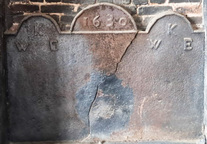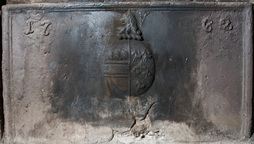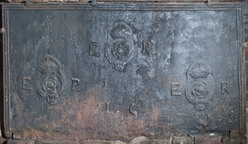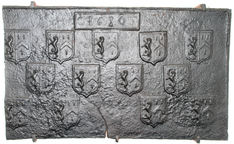-
1311
Description: Rectangular with three arches; twisted rope edging (top and sides); in each of the two outer arches, initials 'WKE' in triad; in the central arch, which is higher than the two outer ones and bordered at the base by twisted rope, the date 1630.
Notes: The triple arched form is unusual. The initials are presumed to refer to a husband and wife whose surname began with 'K'
Inscription: 1630 / WKE [triad] WKE [triad]
- Decoration tags:
- rectangular with three arches (shape)
- rope (edging)
- carved stamps
- individual letters
- individual numbers
- text
Manufactured: in 1630 possibly in the Shropshire area of England.
Current location: Castle Lodge, Castle Square, Ludlow, Shropshire, England.
Citation: Moran, M., 2003, Vernacular Buildings of Shropshire (Almeley, Logaston Press).
- Attached to series:
- Date & initials firebacks
-
1317
Description: Rectangular; cavetto-moulded edging (top and sides); date, in s florid style, split between top corners; central oval shield of impaled arms surmounted by a crest of a lion's head erased upon a wreath.
Notes: George Worge (1705-65), of Starr’s Green, Battle, sometime steward of the Battle Abbey estate, married Elizabeth (1707-66), eldest daughter of John Collier, town clerk of Hastings, in 1727. The arms of Worge have been variously blazoned, but most commonly they are: gules, a fess ermine cotised argent, in chief three lion’s heads erased of the last; Collier - argent, on a chevron azure, between three unicorns courant couped gules, as many oak sprigs fructed proper. The arms and crest in the same form can be seen on a fireback with an elaborate border (no. 757).
Inscription: 17 62
Arms: Worge impaling Collier (George and Elizabeth Worge)
- Decoration tags:
- rectangular (shape)
- cavetto (edging)
- carved stamps
- individual numbers
- heraldic
- armorial
- text
Manufactured: in 1762 probably at Robertsbridge Furnace, Salehurst in the Weald area of England.
Current location: Great Dixter, Northiam, East Sussex, England.
- Attached to series:
- Worge/Collier series
- Personal armorial firebacks
-
1147
Description: Rectangular shape; triple fillet moulded edging (top and sides); overpressed stamp, repeated three times (top centre and below, to left and right) of a crowned rose within a circular garter, each with the initials ER to left and right respectively; lower centre, the initials IC.
Notes: The rose and crown stamp bears striking similarities to rose and crown designs used to mark some bronze cannon of the Tudor period. The initials ER could refer to Edward VI (1547-53) or Elizabeth I (1558-1603). The initials IC most probably relate to the person for whom the fireback was made.
Inscription: ER [thrice] / I C
- Decoration tags:
- rectangular (shape)
- triple fillet (edging)
- carved stamps
- individual letters
- heraldic
- royal
- text
Manufactured: in the mid- to late-16th century in the Weald area of England.
Current location: in private hands, Rolvenden, Kent, England.
- Attached to series:
- Miscellaneous royal firebacks
- Miscellaneous stamp firebacks
-
1008
Description: Rectangular; twisted rope edging on top and (probably both) sides; cavetto-moulded-edged rectangle top centre, enclosing date between initials; 13 shields of Ayloffe impaling Sulyard in three rows (5-4-4), the bottom row having a gap between the middle pair of shields; Ayloffe: sable, a lion rampant Or, collared gules, between three crosses formy of the second; Sulyard: argent, a chevron gules between three pheons inverted sable.
Notes: William Ayloffe (c1535-1584) of Bretons, Hornchurch, Essex, Justice of the Court of Queen’s Bench, married (c1560) Jane, dau. of Sir Eustace Sulyard, of Runwell, Essex. About 110mm of the left side has broken off suggesting an original width of 1340mm. The initials 'CT' are likely to be those of Charles Tyler, a founder whose working life and that of his family have strong parallels with the occurrence of these firebacks.
Inscription: C 1610 T
Arms: Ayloffe impaling Sulyard (William Ayloffe of Bretons, Hornchurch)
- Decoration tags:
- rectangular (shape)
- rope (edging)
- carved stamps
- individual letters
- individual numbers
- armorial
- text
Manufactured: in 1610 possibly at Bedgebury Furnace, Goudhurst in the Weald area of England.
Current location: Wye College, High Street, Wye, Kent, England.
- Attached to series:
- Ayloffe series
- Personal armorial firebacks



